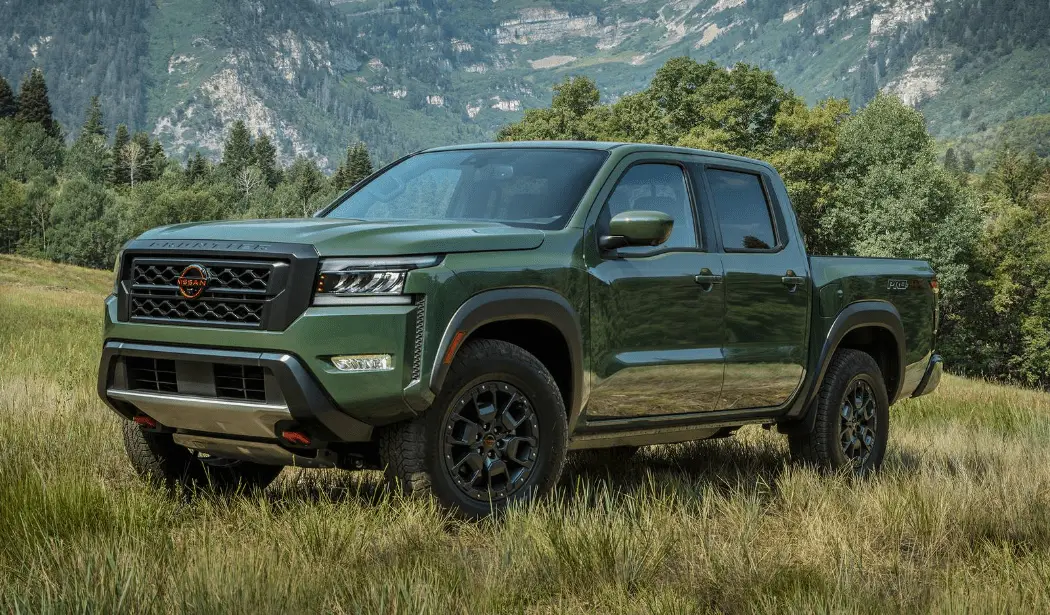Nissan FRONTIER 2023 Rear Cross Traffic Alert (RCTA) and Cruise control
A full range of cutting-edge safety and convenience technologies, such as intelligent cruise control and rear cross-traffic alert (RCTA), are available on the 2023 Nissan Frontier. By sending out notifications when it detects other vehicles or impediments when the car is in reverse, RCTA improves safety during parking and backing out of confined places. In contrast, the Frontier’s Cruise Control system provides adaptive features that make driving on the highway more comfortable and less taxing on the driver by enabling the vehicle to maintain a certain speed and even modify it in response to traffic conditions. These features demonstrate Nissan’s commitment to providing a comprehensive driving experience by fusing convenience and security to make every trip in the Frontier safe and pleasurable.
2023 Nissan Frontier Specs, Price, Features and Mileage (Brochure)
Rear Cross Traffic Alert (RCTA)
WARNING
Failure to follow the warnings and instructions for proper use of the RCTA system could result in serious injury or death.
- The RCTA system is not a replacement for proper driving procedures and is not designed to prevent contact with vehicles or objects. When backing out of a parking space, always use the side and rear mirrors and turn and look in the direction your vehicle will move. Never rely solely on the RCTA system.
The RCTA system will assist you when backing out from a parking space. When the vehicle is in reverse, the system is designed to detect other vehicles approaching from the right or left of the vehicle. If the system detects cross traffic, it will alert you.
RCTA SYSTEM OPERATION
- Side BSW/RCTA Indicator Light
- BSW/RCTA Indicator
The RCTA system can help alert the driver of an approaching vehicle when the driver is backing out of a parking space. When the shift position is in R (Reverse) and the vehicle speed is less than approximately 5 mph (8 km/h), the RCTA system is operational. If the radar detects an approaching vehicle from either side, the system chimes (once) and the side BSW/RCTA indicator light flashes on the side the vehicle is approaching from. 
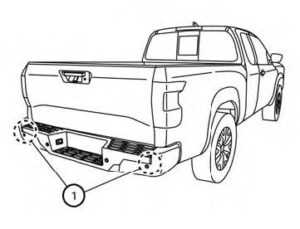
The RCTA system uses radar sensors 1O installed on both sides near the rear bumper to detect an approaching vehicle. The radar sensors 1O can detect an approaching vehicle from up to approximately 66 ft (20 m) away.
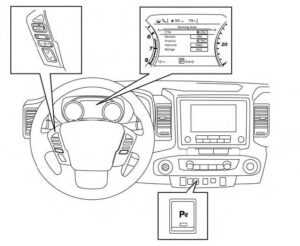
HOW TO ENABLE/DISABLE THE RCTA SYSTEM
When the RCTA system is enabled in the vehicle information display, the system can be turned off temporarily by pushing the Parking Aids system switch.
Perform the following steps to enable or disable the RCTA system:
- Press the button until “Settings” displays in the vehicle information display.
- Use the button to select Driver Assistance” and press ENTER.
- Select “Parking Aids” and press ENTER.
- Select “CTA” and press the ENTER button to turn the system on or off.
- Push the Parking Aids system switch to turn the system on or off.
NOTE:
When enabling/disabling the system, the system setting will be retained even if the engine is restarted.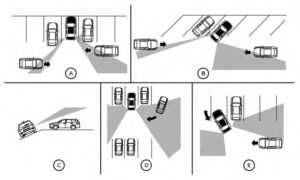
RCTA SYSTEM LIMITATIONS
Listed below are the system limitations for the RCTA system. Failure to operate the vehicle in accordance with these system limitations could result in serious injury or death.
- Always check your surroundings and turn to check what is behind you before backing up. The radar sensors detect approaching (moving) vehicles.
The radar sensors cannot detect every object such as:- Pedestrians, bicycles, motorcycles, animals or child-operated toy vehicles
- A vehicle that is passing at speeds greater than approximately 19 mph (30 km/h)
- A vehicle that is passing at speeds lower than approximately 5 mph (8 km/h)
- The radar sensors may not detect approaching vehicles in certain situations:
- Illustration OA: When a vehicle parked next to you obstructs the beam of the radar sensor.
- Illustration OB: When the vehicle is parked in an angled parking space.
- Illustration OC: When the vehicle is parked on the inclined ground.
- Illustration OD: When an approaching vehicle turns into your vehicle’s parking lot aisle.
- Illustration OE: When the angle formed by your vehicle and the approaching vehicle is small.
- The following conditions may reduce the ability of the radar to detect other vehicles:
- Severe weather
- Road spray
- Ice/frost/snow/dirt build-up on the vehicle
- Do not attach stickers (including transparent material), install accessories, or apply additional paint near the radar sensors. These conditions may reduce the ability of the radar to detect other vehicles.
- Excessive noise (e.g., audio system volume, open vehicle window) will interfere with the chime sound, and it may not be heard.
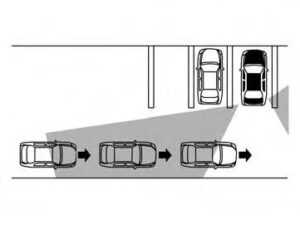
Illustration 1
NOTE:
In the case of several vehicles approaching in a row (Illustration 1) or in the opposite direction (Illustration 2), a chime may not be sounded by the RCTA system after the first vehicle passes the sensors.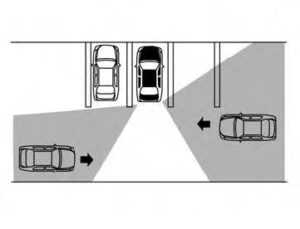
Illustration 2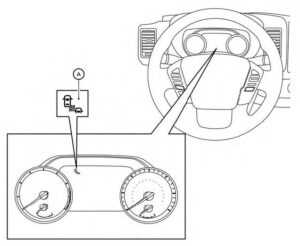
SYSTEM TEMPORARILY UNAVAILABLE
When radar blockage is detected, the system will be deactivated automatically. The “Unavailable Side Radar Obstruction” warning message will appear and the BSW/RCTA indicator (white) will blink OA in the vehicle information display. The systems are not available until the conditions no longer exist. The radar sensors may be blocked by temporary ambient conditions such as splashing water, mist, or fog. The blocked condition may also be caused by conditions such as ice, snow, frost, or dirt obstructing the radar sensors.
NOTE:
If the BSW system stops working, the RCTA system will also stop working.
Action to take
When the above conditions no longer exist, the system will resume automatically.
Malfunction
When the RCTA system malfunctions, it will turn off automatically. The system malfunctioning warning message with the BSW/RCTA indicator (orange) will appear in the vehicle information display.
NOTE:
If the BSW system stops working, the RCTA system will also stop working.
Action to take
Stop the vehicle in a safe location, place the vehicle in the P (Park) position, turn the engine off, and restart the engine. If the message continues to appear, have the system checked. It is recommended that you visit a NISSAN dealer for this service.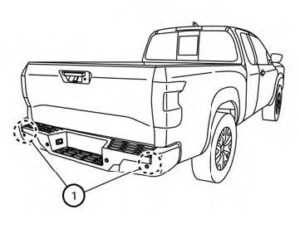
SYSTEM MAINTENANCE
The two radar sensors 1O for the BSW and RCTA systems are located near the rear bumper. Always keep the area near the radar sensors clean. The radar sensors may be blocked by temporary ambient conditions such as splashing water, mist or fog. The blocked condition may also be caused by objects such as ice, frost or dirt obstructing the radar sensors. Check for and remove objects obstructing the area around the radar sensors. Do not attach stickers (including transparent material), install accessories or apply additional paint near the radar sensors. Do not strike or damage the area around the radar sensors. It is recommended that you visit a NISSAN dealer if the area around the radar sensors is damaged due to a collision.
Radiofrequency statement
For the USA
FCC ID: OAYSRR3B
This device complies with Part 15 of the FCC Rules.
Operation is subject to the following two conditions:
- This device may not cause harmful interference, and
- This device must accept any interference received, including interference that may cause undesired operation.+
CAUTION TO USERS
Changes or modifications not expressly approved by the party responsible for compliance could void the user’s authority to operate the equipment.
For Canada IC ID: 4135A-SRR3B
This device contains license-exempt transmitter(s)/receiver(s) that comply with Innovation, Science and Economic Development Canada’s license-exempt RSS(s).
Operation is subject to the following two conditions:
- This device may not cause interference.
- This device must accept any interference, including interference that may cause undesired operation of the device.
Radiofrequency radiation exposure information:
This equipment complies with radiation exposure limits set forth for an uncontrolled environment. This equipment should be installed and operated with a minimum distance of 20 cm between the radiator and the body of any person, user, or bystander.
CRUISE CONTROL (if so equipped)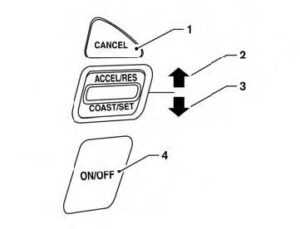
PRECAUTIONS ON CRUISE CONTROL
- CANCEL switch
- ACCEL/RES switch
- COAST/SET switch
- ON/OFF switch
- If the cruise control system malfunctions, it cancels automatically. The (green) indicator illuminates the vehicle information display and then blinks to warn the driver.
- If the (green) indicator blinks, push the ON/OFF switch off and have the system checked. It is recommended that you visit a NISSAN dealer for this service.
- The (green) indicator may blink when the ON/OFF switch is pushed ON while pushing the ACCEL/RES, COAST/SET, or CANCEL switch. To properly set the cruise control system, use the following procedures.
WARNING
Do not use the cruise control when driving under the following conditions:
- When it is not possible to keep the vehicle at a set speed.
- In heavy traffic or in traffic that varies in speed.
- On winding or hilly roads.
- On slippery roads (rain, snow, ice, etc.).
- In very windy areas.
Doing so could cause a loss of vehicle control and result in an accident.
CRUISE CONTROL OPERATIONS
The cruise control allows driving at a speed between 25 – 89 mph (40 – 144 km/h) without keeping your foot on the accelerator pedal.
To turn on the cruise control, push the ON/OFF switch on. The (white) indicator in the vehicle information display will illuminate.
To set cruising speed, accelerate the vehicle to the desired speed, push the COAST/SET switch, and release it. The (green) indicator in the vehicle information display will illuminate. Take your foot off the accelerator pedal. Your vehicle maintains the set speed.
- To pass another vehicle, depress the accelerator pedal. When you release the pedal, the vehicle returns to the previously set speed.
- The vehicle may not maintain the set speed when going up or down steep hills. If this happens, drive without cruise control.
To cancel the preset speed, use one of the following three methods:
- Push the CANCEL switch; the indicator in the vehicle information display goes out.
- Tap the brake pedal; the goes out. indicator
- Push the ON/OFF switch off. The indicator in the vehicle information display goes out.
The cruise control is automatically canceled and the indicator in the vehicle information display goes out if:
- You depress the brake pedal while pushing the ACCEL/RES or COAST/SET switch. The preset speed is deleted from memory.
- The vehicle slows down more than 8 mph (13 km/h) below the set speed.
- You move the shift lever to N (Neutral).
To reset at a faster cruising speed, use one of the following three methods:
- Depress the accelerator pedal. When the vehicle attains the desired speed, push and release the COAST/SET switch.
- Push and hold the ACCEL/RES switch. When the vehicle attains the speed you desire, release the switch.
- Push and release the ACCEL/RES switch. Each time you do this, the set speed increases by about 1 mph (1.6 km/h).
To reset at a slower cruising speed, use one of the following three methods:
- Lightly tap the brake pedal. When the vehicle attains the desired speed, push the COAST/SET switch and release it.
- Push and hold the COAST/SET switch. Release the switch when the vehicle slows to the desired speed.
- Push and release the COAST/SET switch. Each time you do this, the set speed decreases by about 1 mph (1.6 km/h).
To resume the preset speed, push and release the ACCEL/RES switch. The vehicle returns to the last set cruising speed when the vehicle speed is over 25 mph (40 km/h).
FAQ
RCTA is designed to alert the driver to vehicles or obstacles approaching from the sides when the vehicle is in reverse, enhancing safety while backing up.
RCTA often provides audible and visual alerts, such as warning tones and indicators on the dashboard or infotainment screen.
RCTA is most effective in situations with clear visibility, but its performance may be affected by factors like heavy rain or snow.
Many vehicles allow drivers to turn RCTA on or off through the settings menu.
RCTA availability may vary by trim level and optional packages.
RCTA is primarily designed to detect vehicles, and its ability to detect pedestrians and cyclists may vary by model.
Drivers should always check their surroundings visually before reversing and use RCTA as an additional safety aid.
Yes, RCTA can typically be turned off through the vehicle’s settings.
The Cruise Control system allows the driver to set a desired speed, and the vehicle will maintain that speed without the need for constant throttle input.
The Frontier may feature an adaptive Cruise Control system, which can adjust the vehicle’s speed to maintain a safe following distance from the vehicle ahead.
Adaptive Cruise Control enhances safety by automatically adjusting the vehicle’s speed to maintain a safe distance from the vehicle ahead, reducing the need for manual speed adjustments.
Yes, drivers can typically adjust the set speed while using Cruise Control.
Tapping the brake pedal usually deactivates Cruise Control temporarily, allowing the driver to regain control.
Cruise Control systems usually have a maximum speed limit, and it can vary by vehicle.
Cruise Control is generally designed for highway use and may not be suitable for off-road conditions.
Useful Link
View Full User Guide: Nissan FRONTIER 2023 User Guide
Download Manuals: https://www.nissanusa.com/owners/ownership/manuals-guides.html
2023 Nissan Frontier Specs, Price, Features and Mileage (Brochure)

